University Health Care Research: Article Critique and Analysis
VerifiedAdded on 2023/01/20
|7
|1648
|40
Report
AI Summary
This report provides a critical analysis of a health care research article focusing on the experiences of people with visible differences. The report begins by examining the selection of the research topic and the formulation of research questions, emphasizing the importance of clarity and relevance. It then delves into the literature review, assessing its depth and how it supports the research. The core of the report evaluates the choice of research approach, including the use of mixed methods (qualitative and quantitative) and the rationale behind them. The report also scrutinizes the research design and measurement techniques, particularly the selection of cases and the consideration of time elements. The author highlights the strengths and weaknesses of the article's methodology and its contribution to the field of health psychology. The report concludes by assessing the overall quality of the research and its implications.
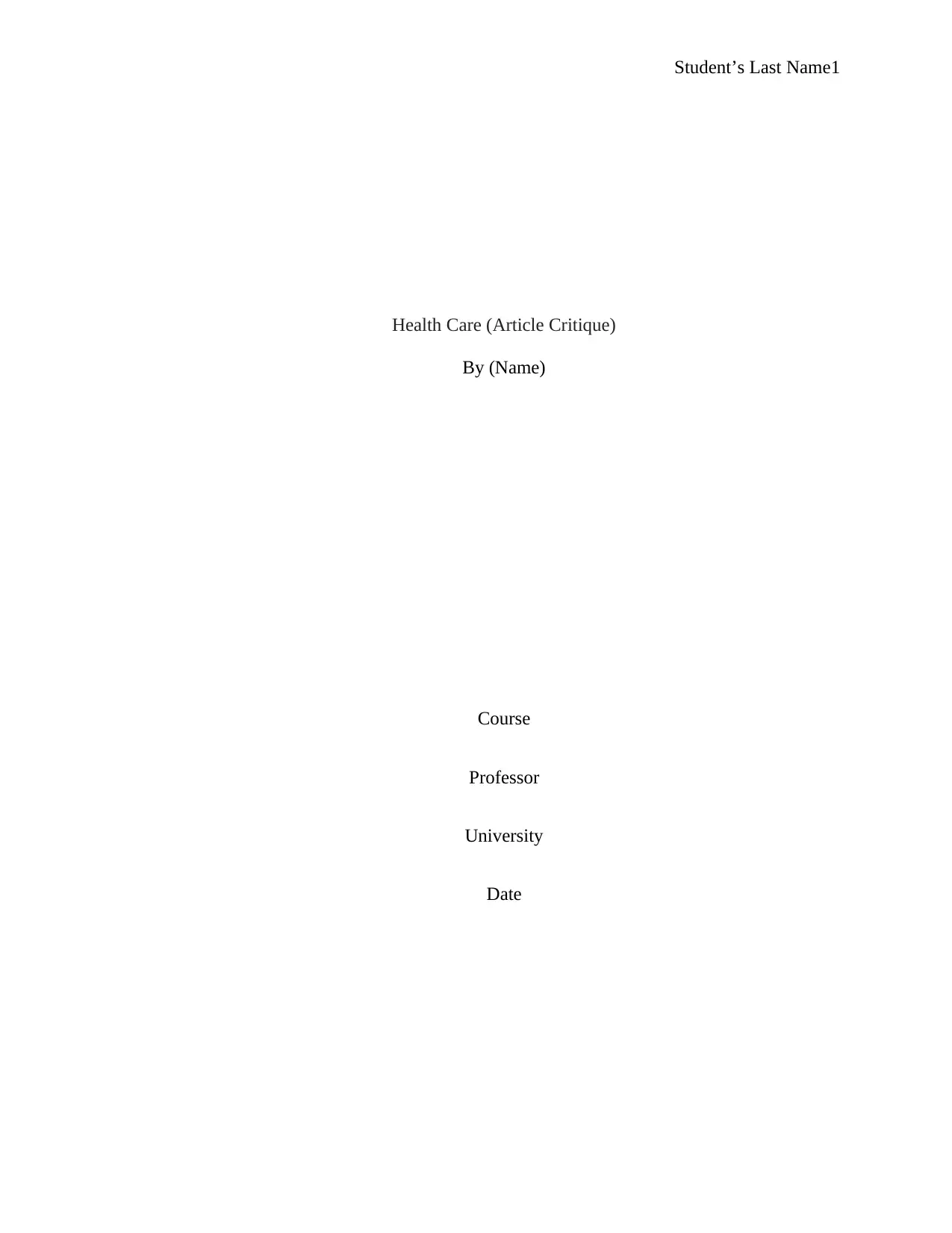
Student’s Last Name1
Health Care (Article Critique)
By (Name)
Course
Professor
University
Date
Health Care (Article Critique)
By (Name)
Course
Professor
University
Date
Paraphrase This Document
Need a fresh take? Get an instant paraphrase of this document with our AI Paraphraser
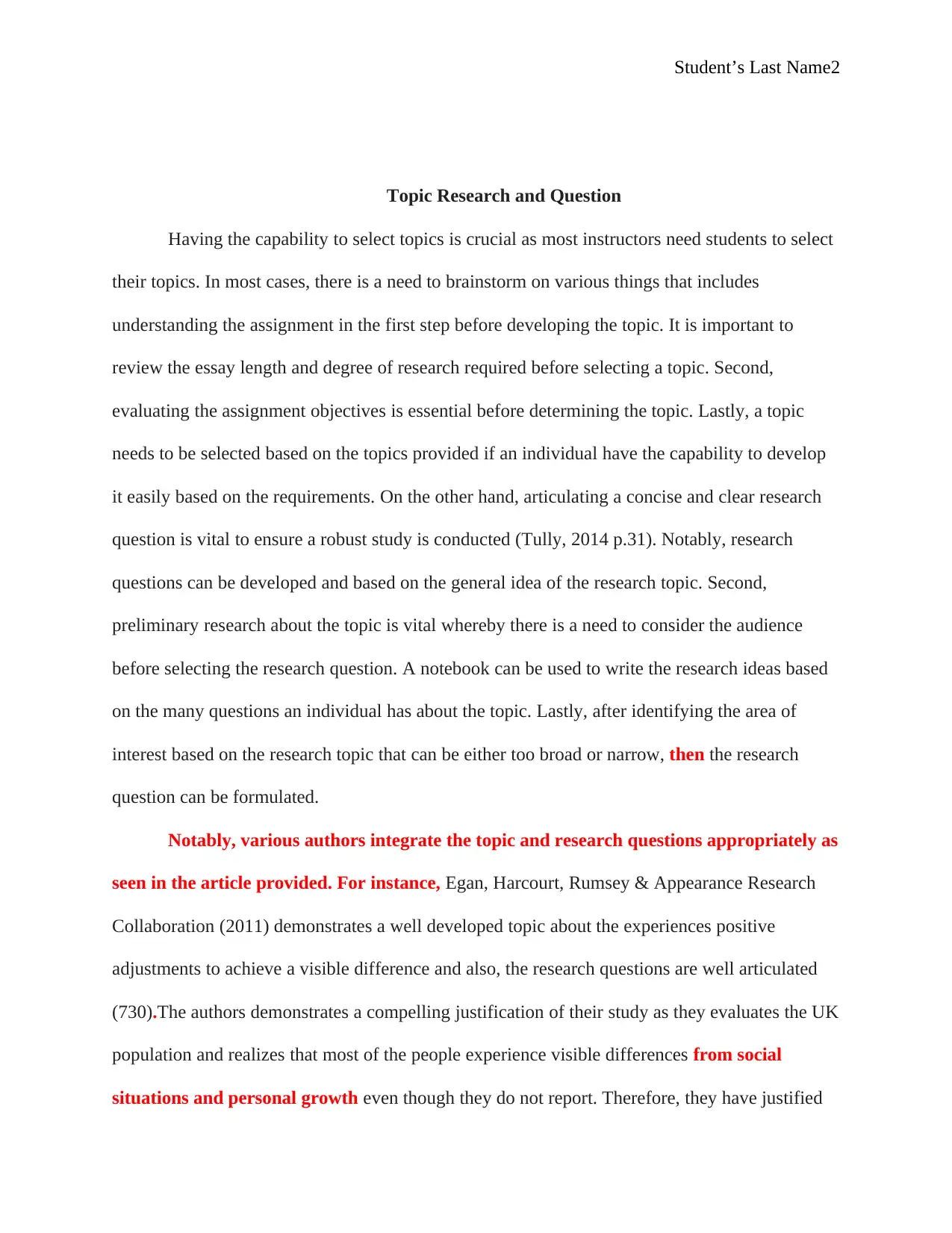
Student’s Last Name2
Topic Research and Question
Having the capability to select topics is crucial as most instructors need students to select
their topics. In most cases, there is a need to brainstorm on various things that includes
understanding the assignment in the first step before developing the topic. It is important to
review the essay length and degree of research required before selecting a topic. Second,
evaluating the assignment objectives is essential before determining the topic. Lastly, a topic
needs to be selected based on the topics provided if an individual have the capability to develop
it easily based on the requirements. On the other hand, articulating a concise and clear research
question is vital to ensure a robust study is conducted (Tully, 2014 p.31). Notably, research
questions can be developed and based on the general idea of the research topic. Second,
preliminary research about the topic is vital whereby there is a need to consider the audience
before selecting the research question. A notebook can be used to write the research ideas based
on the many questions an individual has about the topic. Lastly, after identifying the area of
interest based on the research topic that can be either too broad or narrow, then the research
question can be formulated.
Notably, various authors integrate the topic and research questions appropriately as
seen in the article provided. For instance, Egan, Harcourt, Rumsey & Appearance Research
Collaboration (2011) demonstrates a well developed topic about the experiences positive
adjustments to achieve a visible difference and also, the research questions are well articulated
(730).The authors demonstrates a compelling justification of their study as they evaluates the UK
population and realizes that most of the people experience visible differences from social
situations and personal growth even though they do not report. Therefore, they have justified
Topic Research and Question
Having the capability to select topics is crucial as most instructors need students to select
their topics. In most cases, there is a need to brainstorm on various things that includes
understanding the assignment in the first step before developing the topic. It is important to
review the essay length and degree of research required before selecting a topic. Second,
evaluating the assignment objectives is essential before determining the topic. Lastly, a topic
needs to be selected based on the topics provided if an individual have the capability to develop
it easily based on the requirements. On the other hand, articulating a concise and clear research
question is vital to ensure a robust study is conducted (Tully, 2014 p.31). Notably, research
questions can be developed and based on the general idea of the research topic. Second,
preliminary research about the topic is vital whereby there is a need to consider the audience
before selecting the research question. A notebook can be used to write the research ideas based
on the many questions an individual has about the topic. Lastly, after identifying the area of
interest based on the research topic that can be either too broad or narrow, then the research
question can be formulated.
Notably, various authors integrate the topic and research questions appropriately as
seen in the article provided. For instance, Egan, Harcourt, Rumsey & Appearance Research
Collaboration (2011) demonstrates a well developed topic about the experiences positive
adjustments to achieve a visible difference and also, the research questions are well articulated
(730).The authors demonstrates a compelling justification of their study as they evaluates the UK
population and realizes that most of the people experience visible differences from social
situations and personal growth even though they do not report. Therefore, they have justified
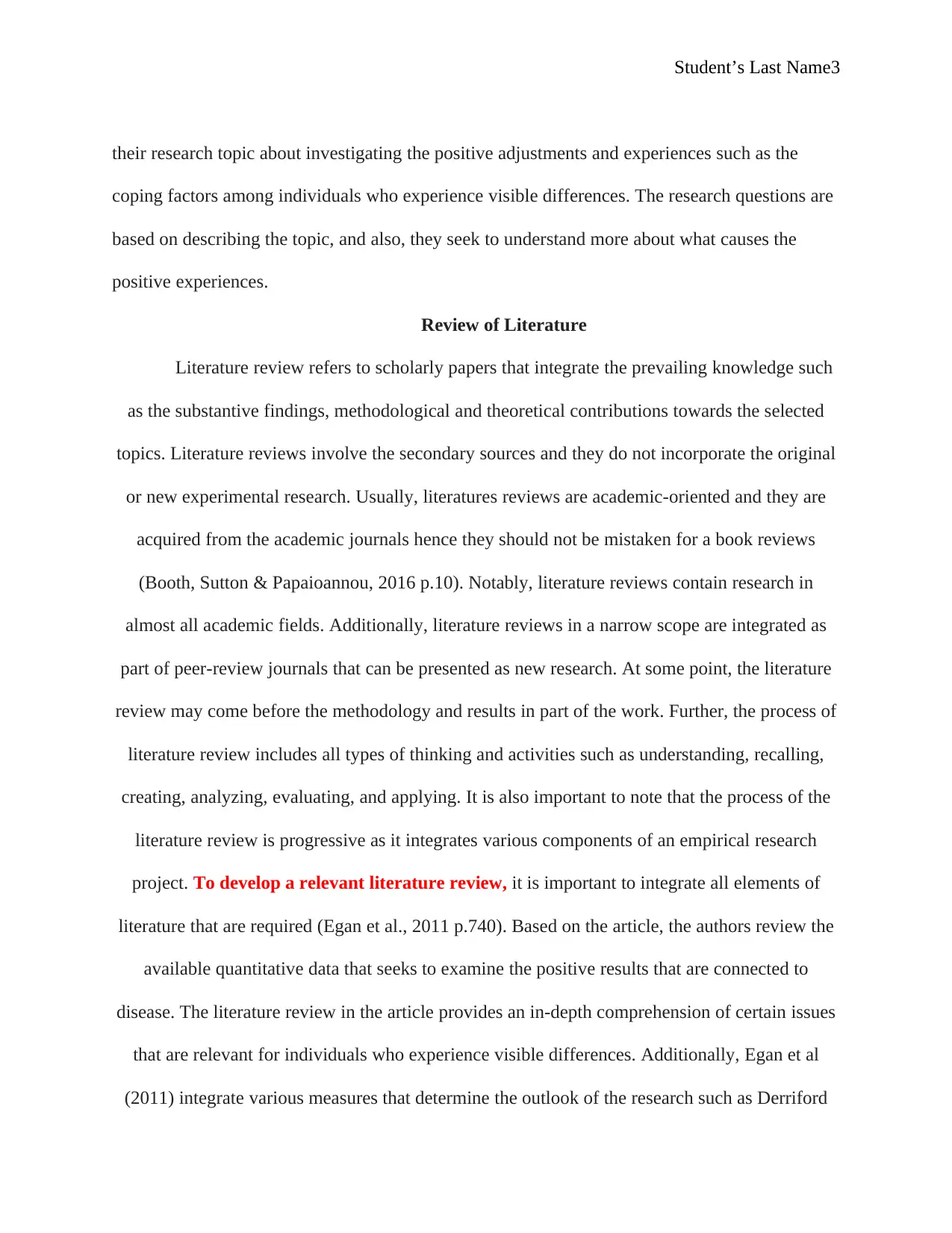
Student’s Last Name3
their research topic about investigating the positive adjustments and experiences such as the
coping factors among individuals who experience visible differences. The research questions are
based on describing the topic, and also, they seek to understand more about what causes the
positive experiences.
Review of Literature
Literature review refers to scholarly papers that integrate the prevailing knowledge such
as the substantive findings, methodological and theoretical contributions towards the selected
topics. Literature reviews involve the secondary sources and they do not incorporate the original
or new experimental research. Usually, literatures reviews are academic-oriented and they are
acquired from the academic journals hence they should not be mistaken for a book reviews
(Booth, Sutton & Papaioannou, 2016 p.10). Notably, literature reviews contain research in
almost all academic fields. Additionally, literature reviews in a narrow scope are integrated as
part of peer-review journals that can be presented as new research. At some point, the literature
review may come before the methodology and results in part of the work. Further, the process of
literature review includes all types of thinking and activities such as understanding, recalling,
creating, analyzing, evaluating, and applying. It is also important to note that the process of the
literature review is progressive as it integrates various components of an empirical research
project. To develop a relevant literature review, it is important to integrate all elements of
literature that are required (Egan et al., 2011 p.740). Based on the article, the authors review the
available quantitative data that seeks to examine the positive results that are connected to
disease. The literature review in the article provides an in-depth comprehension of certain issues
that are relevant for individuals who experience visible differences. Additionally, Egan et al
(2011) integrate various measures that determine the outlook of the research such as Derriford
their research topic about investigating the positive adjustments and experiences such as the
coping factors among individuals who experience visible differences. The research questions are
based on describing the topic, and also, they seek to understand more about what causes the
positive experiences.
Review of Literature
Literature review refers to scholarly papers that integrate the prevailing knowledge such
as the substantive findings, methodological and theoretical contributions towards the selected
topics. Literature reviews involve the secondary sources and they do not incorporate the original
or new experimental research. Usually, literatures reviews are academic-oriented and they are
acquired from the academic journals hence they should not be mistaken for a book reviews
(Booth, Sutton & Papaioannou, 2016 p.10). Notably, literature reviews contain research in
almost all academic fields. Additionally, literature reviews in a narrow scope are integrated as
part of peer-review journals that can be presented as new research. At some point, the literature
review may come before the methodology and results in part of the work. Further, the process of
literature review includes all types of thinking and activities such as understanding, recalling,
creating, analyzing, evaluating, and applying. It is also important to note that the process of the
literature review is progressive as it integrates various components of an empirical research
project. To develop a relevant literature review, it is important to integrate all elements of
literature that are required (Egan et al., 2011 p.740). Based on the article, the authors review the
available quantitative data that seeks to examine the positive results that are connected to
disease. The literature review in the article provides an in-depth comprehension of certain issues
that are relevant for individuals who experience visible differences. Additionally, Egan et al
(2011) integrate various measures that determine the outlook of the research such as Derriford
⊘ This is a preview!⊘
Do you want full access?
Subscribe today to unlock all pages.

Trusted by 1+ million students worldwide

Student’s Last Name4
Appearance Scale that does not offer insights about the individuals with compromised outlooks
can interpret the appearance-related situations positively (743).In this case, the literature review
is relevant as it captures the personal and rich accounts experiences as well as the perceptions of
those who live with visible differences.
Choice of Approach
Overall decisions are based on the approaches that are used to study topics and they are
embedded on researchers’ philosophical assumptions that are employed in specific research
methods. Various choices of approaches include the quantitative, qualitative, and mixed
approaches that are employed in research. To start with the quantitative approach, it focuses on
the comprehension of the phenomenon from a closer dimension. The qualitative approach
attempts to approximate a phenomenon based on the number of people involved in the survey
(Neuman, 2014 p.10). This approach is greatly used in examining two elements and also helps in
making predictions. On the other hand, the qualitative approach seeks to inform about a specific
group’s experiences whereby it integrates field research through observation. This approach is
greatly useful in the social sciences as it explores social interactions by providing in-depth
comprehension of how people act in various situations at specific environments. Lastly, the
mixed approach involves analyzing, collecting, and incorporating quantitative methods such as
surveys and experiments or qualitative methods such as interviews and focus groups. A mixed
approach is useful in developing and testing psychometric instruments that are designed to
improve the prevailing measures.
Egan et al (2011) incorporate the mixed approach whereby the questionnaires were used
as quantitative measures to examine the issues that relate to people experiencing visible
differences (741). On the other hand, the authors used the focus group interviews as qualitative
Appearance Scale that does not offer insights about the individuals with compromised outlooks
can interpret the appearance-related situations positively (743).In this case, the literature review
is relevant as it captures the personal and rich accounts experiences as well as the perceptions of
those who live with visible differences.
Choice of Approach
Overall decisions are based on the approaches that are used to study topics and they are
embedded on researchers’ philosophical assumptions that are employed in specific research
methods. Various choices of approaches include the quantitative, qualitative, and mixed
approaches that are employed in research. To start with the quantitative approach, it focuses on
the comprehension of the phenomenon from a closer dimension. The qualitative approach
attempts to approximate a phenomenon based on the number of people involved in the survey
(Neuman, 2014 p.10). This approach is greatly used in examining two elements and also helps in
making predictions. On the other hand, the qualitative approach seeks to inform about a specific
group’s experiences whereby it integrates field research through observation. This approach is
greatly useful in the social sciences as it explores social interactions by providing in-depth
comprehension of how people act in various situations at specific environments. Lastly, the
mixed approach involves analyzing, collecting, and incorporating quantitative methods such as
surveys and experiments or qualitative methods such as interviews and focus groups. A mixed
approach is useful in developing and testing psychometric instruments that are designed to
improve the prevailing measures.
Egan et al (2011) incorporate the mixed approach whereby the questionnaires were used
as quantitative measures to examine the issues that relate to people experiencing visible
differences (741). On the other hand, the authors used the focus group interviews as qualitative
Paraphrase This Document
Need a fresh take? Get an instant paraphrase of this document with our AI Paraphraser
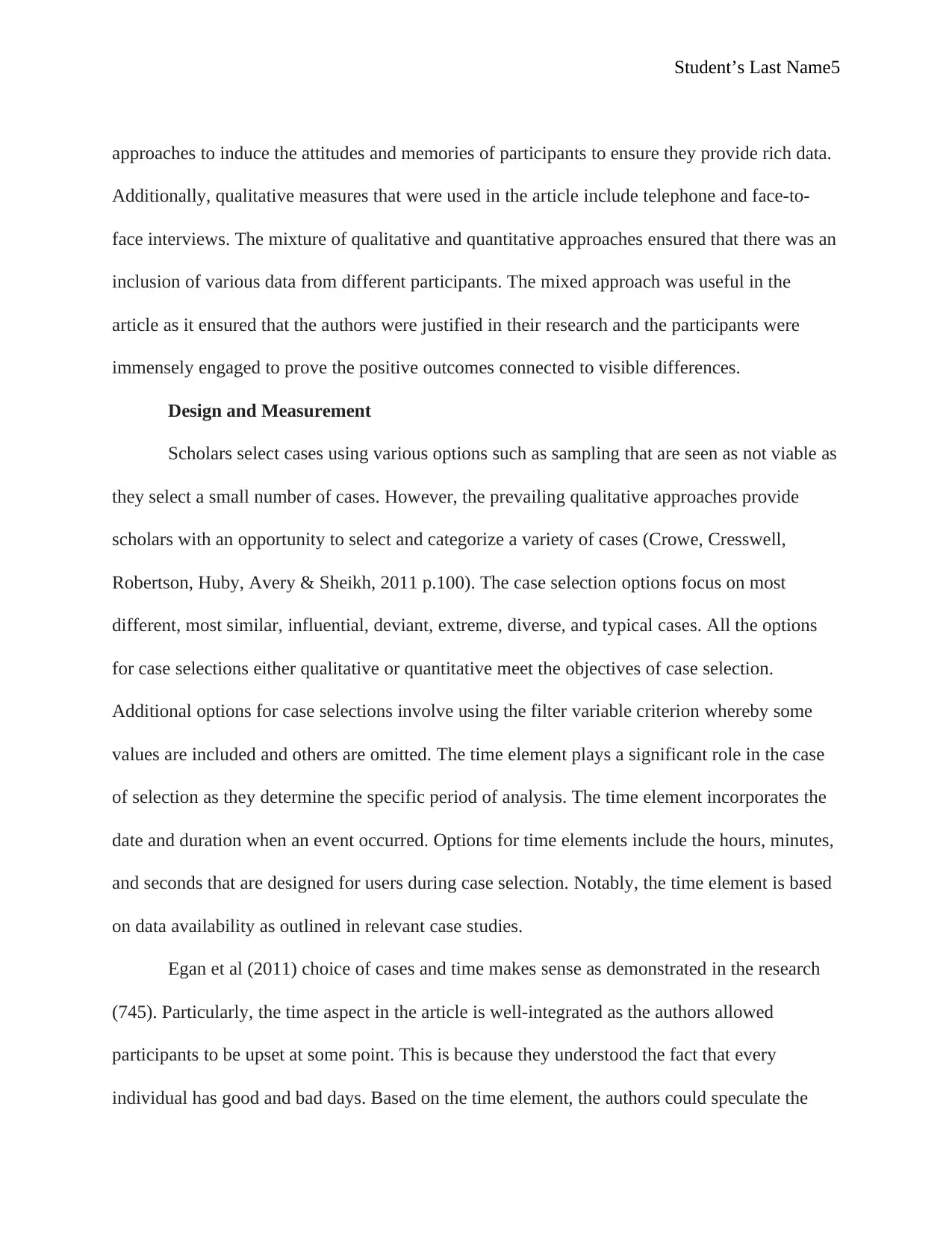
Student’s Last Name5
approaches to induce the attitudes and memories of participants to ensure they provide rich data.
Additionally, qualitative measures that were used in the article include telephone and face-to-
face interviews. The mixture of qualitative and quantitative approaches ensured that there was an
inclusion of various data from different participants. The mixed approach was useful in the
article as it ensured that the authors were justified in their research and the participants were
immensely engaged to prove the positive outcomes connected to visible differences.
Design and Measurement
Scholars select cases using various options such as sampling that are seen as not viable as
they select a small number of cases. However, the prevailing qualitative approaches provide
scholars with an opportunity to select and categorize a variety of cases (Crowe, Cresswell,
Robertson, Huby, Avery & Sheikh, 2011 p.100). The case selection options focus on most
different, most similar, influential, deviant, extreme, diverse, and typical cases. All the options
for case selections either qualitative or quantitative meet the objectives of case selection.
Additional options for case selections involve using the filter variable criterion whereby some
values are included and others are omitted. The time element plays a significant role in the case
of selection as they determine the specific period of analysis. The time element incorporates the
date and duration when an event occurred. Options for time elements include the hours, minutes,
and seconds that are designed for users during case selection. Notably, the time element is based
on data availability as outlined in relevant case studies.
Egan et al (2011) choice of cases and time makes sense as demonstrated in the research
(745). Particularly, the time aspect in the article is well-integrated as the authors allowed
participants to be upset at some point. This is because they understood the fact that every
individual has good and bad days. Based on the time element, the authors could speculate the
approaches to induce the attitudes and memories of participants to ensure they provide rich data.
Additionally, qualitative measures that were used in the article include telephone and face-to-
face interviews. The mixture of qualitative and quantitative approaches ensured that there was an
inclusion of various data from different participants. The mixed approach was useful in the
article as it ensured that the authors were justified in their research and the participants were
immensely engaged to prove the positive outcomes connected to visible differences.
Design and Measurement
Scholars select cases using various options such as sampling that are seen as not viable as
they select a small number of cases. However, the prevailing qualitative approaches provide
scholars with an opportunity to select and categorize a variety of cases (Crowe, Cresswell,
Robertson, Huby, Avery & Sheikh, 2011 p.100). The case selection options focus on most
different, most similar, influential, deviant, extreme, diverse, and typical cases. All the options
for case selections either qualitative or quantitative meet the objectives of case selection.
Additional options for case selections involve using the filter variable criterion whereby some
values are included and others are omitted. The time element plays a significant role in the case
of selection as they determine the specific period of analysis. The time element incorporates the
date and duration when an event occurred. Options for time elements include the hours, minutes,
and seconds that are designed for users during case selection. Notably, the time element is based
on data availability as outlined in relevant case studies.
Egan et al (2011) choice of cases and time makes sense as demonstrated in the research
(745). Particularly, the time aspect in the article is well-integrated as the authors allowed
participants to be upset at some point. This is because they understood the fact that every
individual has good and bad days. Based on the time element, the authors could speculate the
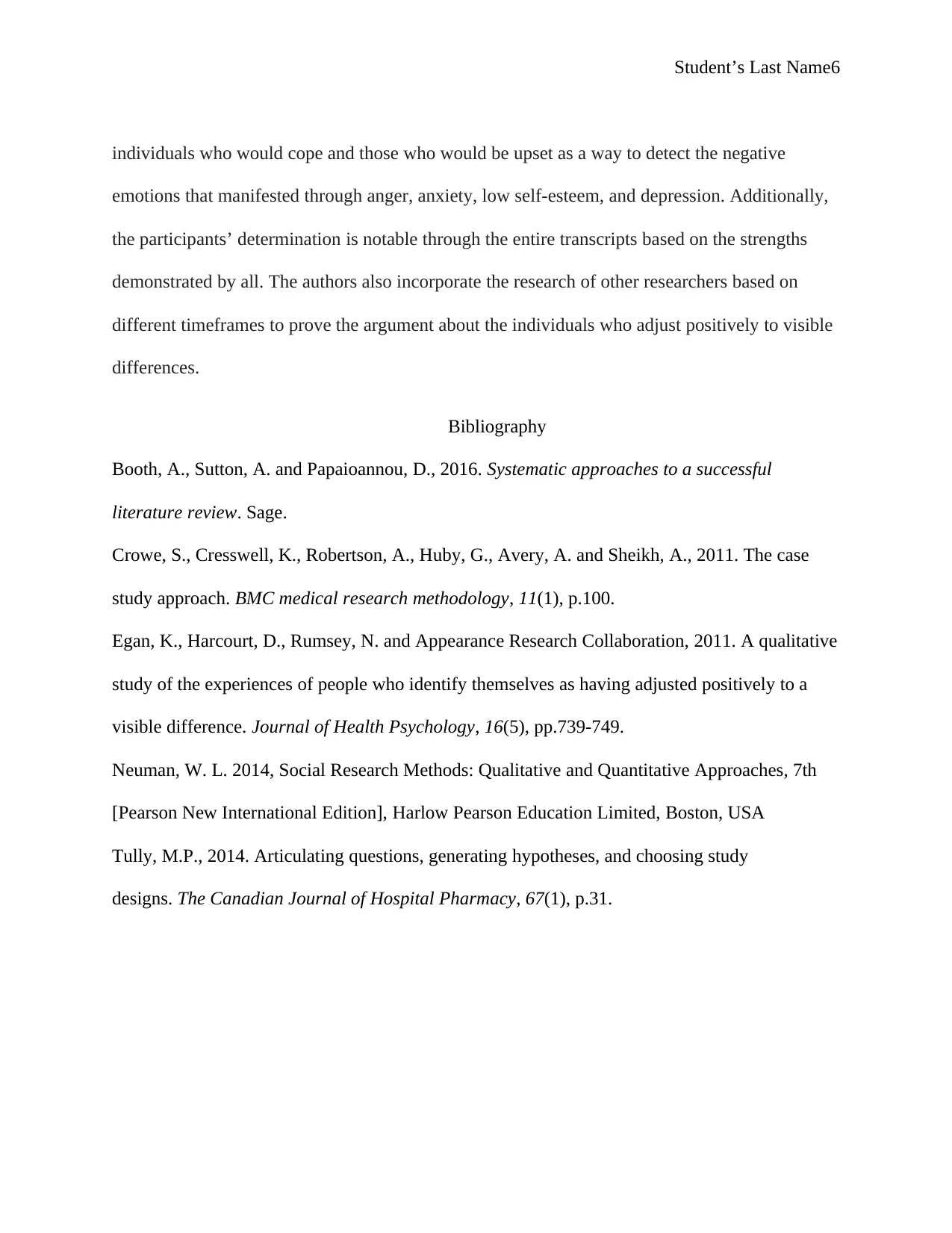
Student’s Last Name6
individuals who would cope and those who would be upset as a way to detect the negative
emotions that manifested through anger, anxiety, low self-esteem, and depression. Additionally,
the participants’ determination is notable through the entire transcripts based on the strengths
demonstrated by all. The authors also incorporate the research of other researchers based on
different timeframes to prove the argument about the individuals who adjust positively to visible
differences.
Bibliography
Booth, A., Sutton, A. and Papaioannou, D., 2016. Systematic approaches to a successful
literature review. Sage.
Crowe, S., Cresswell, K., Robertson, A., Huby, G., Avery, A. and Sheikh, A., 2011. The case
study approach. BMC medical research methodology, 11(1), p.100.
Egan, K., Harcourt, D., Rumsey, N. and Appearance Research Collaboration, 2011. A qualitative
study of the experiences of people who identify themselves as having adjusted positively to a
visible difference. Journal of Health Psychology, 16(5), pp.739-749.
Neuman, W. L. 2014, Social Research Methods: Qualitative and Quantitative Approaches, 7th
[Pearson New International Edition], Harlow Pearson Education Limited, Boston, USA
Tully, M.P., 2014. Articulating questions, generating hypotheses, and choosing study
designs. The Canadian Journal of Hospital Pharmacy, 67(1), p.31.
individuals who would cope and those who would be upset as a way to detect the negative
emotions that manifested through anger, anxiety, low self-esteem, and depression. Additionally,
the participants’ determination is notable through the entire transcripts based on the strengths
demonstrated by all. The authors also incorporate the research of other researchers based on
different timeframes to prove the argument about the individuals who adjust positively to visible
differences.
Bibliography
Booth, A., Sutton, A. and Papaioannou, D., 2016. Systematic approaches to a successful
literature review. Sage.
Crowe, S., Cresswell, K., Robertson, A., Huby, G., Avery, A. and Sheikh, A., 2011. The case
study approach. BMC medical research methodology, 11(1), p.100.
Egan, K., Harcourt, D., Rumsey, N. and Appearance Research Collaboration, 2011. A qualitative
study of the experiences of people who identify themselves as having adjusted positively to a
visible difference. Journal of Health Psychology, 16(5), pp.739-749.
Neuman, W. L. 2014, Social Research Methods: Qualitative and Quantitative Approaches, 7th
[Pearson New International Edition], Harlow Pearson Education Limited, Boston, USA
Tully, M.P., 2014. Articulating questions, generating hypotheses, and choosing study
designs. The Canadian Journal of Hospital Pharmacy, 67(1), p.31.
⊘ This is a preview!⊘
Do you want full access?
Subscribe today to unlock all pages.

Trusted by 1+ million students worldwide

Student’s Last Name7
1 out of 7
Related Documents
Your All-in-One AI-Powered Toolkit for Academic Success.
+13062052269
info@desklib.com
Available 24*7 on WhatsApp / Email
![[object Object]](/_next/static/media/star-bottom.7253800d.svg)
Unlock your academic potential
Copyright © 2020–2025 A2Z Services. All Rights Reserved. Developed and managed by ZUCOL.




